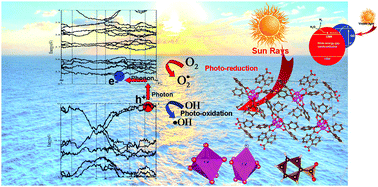Quantum dots in photocatalytic applications: efficiently enhancing visible light photocatalytic activity by integrating CdO quantum dots as sensitizers†
Abstract
The amalgamation of a wide optical band gap photocatalyst with visible-light-active CdO quantum dots (QDs) as sensitizers is one of the most efficient ways to improve photocatalytic performance under visible light irradiation. The photocatalytic performance of cadmium benzoate ((Cd(C7H5O2)2)3(CH3CN)1) is comprehensively investigated. The estimated optical band gap of cadmium benzoate is 2.64 eV and the EPc and EPv are about −0.09 V (vs. NHE) and +2.55 V (vs. NHE), respectively, which implies that cadmium benzoate possesses a high negative reduction potential of excited electrons due to its higher conduction band position, and hence, the locations of the conduction band minimum and the valence band maximum meet the redox capacity. Thus, this composite photocatalyst exhibits superior activity in visible-light-driven photocatalytic H2 evolution. We found that introducing the QDs enhance the photocatalytic performance towards the visible light region. The electronic band structure shows high k-dispersion bands around the Fermi level, which implies low effective masses, and hence, the high mobility carriers favor the enhancement of the charge transfer process. The mobility of the photogenerated carriers significantly influences the photocatalytic efficiency and the higher photogenerated carriers' mobility enhances the photocatalytic performance. Moreover, the result shows a great effective mass difference between electrons (e−) and holes (h+), which can facilitate the e− and h+ migration and separation, and finally improve the photocatalytic performance. The large mobility difference is useful for the separation of e− and h+, the reduction of the e− and h+ recombination rate, and the improvement of the photocatalytic activity. Thus, cadmium benzoate exhibits rapid generation of e−–h+ pairs with photoexcitation and a high negative reduction potential of excited electrons due to its higher CB position. Based on these results one can conclude that cadmium benzoate satisfied all requirements to be an efficient photocatalyst. This will greatly improve the search efficiency and greatly help experimentalists in saving resources in the exploration of new photocatalysts with good photocatalytic performance.



 Please wait while we load your content...
Please wait while we load your content...